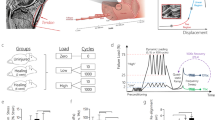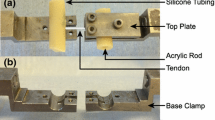Abstract
Tendon is composed of type I collagen fibers, interspersed with proteoglycan matrix and cells. Glycosaminoglycans may play a role in maintaining the structural integrity of tendon, preventing excessive shearing between collagen components. This study tests the hypothesis that tendon extension mechanisms can be altered by modifying the composition of noncollagenous matrix. Tendon explants were treated with phosphate buffered saline (PBS) or PBS + 0.5 U ml−1 chondroitinase ABC. Structural changes were examined using TEM and biochemical analysis, while strain response was examined using confocal microscopy and gross mechanical characterization. Chondroitinase ABC removed 90% of glycosaminoglycans from the matrix. Results demonstrated significant swelling of fibrils and surrounding matrix when incubated in either solution. In response to applied strain, PBS incubated samples demonstrated significantly less sliding between adjacent fibers than nonincubated, and a 33% reduction in maximum force. By contrast, fascicles incubated in chondroitinase ABC demonstrated a similar strain response to nonincubated. Data indicate that collagen-proteoglycan binding characteristics can be influenced by incubation and this, in turn, can influence the preferred extension mechanisms adopted by fascicles. This highlights the importance of maintaining fascicles within their natural environment to prevent structural or mechanical changes prior to subsequent analysis.
Similar content being viewed by others
References
M. Abrahams. Mechanical behaviour of tendon in vitro. Med. Biol. Eng. 5:433–443, 1967.
Arnoczky, S. P., M. Lavagnino, J. H. Whallon, and A. Hoonjan. In situ cell nucleus deformation in tendons under tensile load; a mophological analysis using confocal laser microscopy. J.Orthop. Res. 20:29–35, 2002.
Bailey, A. J., S. P. Robins, and G. Balian. Biological significance of the intermolecular crosslinks of collagen. Nature 251:105–109, 1974.
Banes, A. J., M. Tsuzaki, J. Yamamoto, T. Fischer, B. Brigman, T. Brown, and L. Miller. Mechanoreception at the cellular level: The detection, interpretation, and diversity of responses to mechanical signals. Biochem. Cell Biol. 73:349–365, 1995.
Benjamin, M., and J. R. Ralphs. Tendons and ligaments: An overview. Histol. Histopathol. 12:1135–1144, 1997.
Berenson, M. C., F. T. Blevins, A. H. Plaas, and K. G. Vogel. Proteoglycans of human rotator cuff tendons. J. Orthop. Res. 14:518–525, 1996.
Blevin, F. T. Structure, function and adaptation of tendon. Curr. Opin. Orthop. 7(5): 57–61, 1996.
Blevins, F. T., M. Djurasovic, E. L. Flatow, and K. G. Vogel. Biology of the rotator cuff tendon. Orthop. Clin. N. Am. 28(1):1–15, 1997.
Chimich, D., N. Shrive, C. Frank, L. Marchuk, and R. Bray. Water content alters viscoelastic behavior of the normal adolescent rabbit medial collateral ligament. J. Biomech. 25(8):831–837, 1992.
Covizi, D. Z., S. L. Felisbino, L. Gomes, E. R. Pimentel, and H. F. Carvalho. Regional adaptations in three rat tendons. Tissue Cell 33(5):483–490, 2001.
Cribb, A. M., and J. E. Scott. Tendon response to tensile stress: An ultrastructural investigation of collagen: Proteoglycan interactions in stressed tendon. J. Anat. 187:423–428, 1995.
Evered, D., and J. Whelan. Function of Proteogylcans. London: Wiley Interscience, 1986.
Farndale, R. W., C. A. Sayers, and A. J. Barrett. A direct spectrophotometric microassay for sulphated glycosaminoglycans in cartilage cultures. Connect. Tissue Res. 9:247–248, 1982.
Kastelic, J., and E. Baer. Deformation in tendon collagen. Symp. Soc. Exp. Biol. 34:397–435, 1980.
Kastelic, J., A. Galeski, and E. Baer. The multicomposite structure of tendon. Connect. Tissue Res. 6:11–23, 1978.
Koob, T. Effects of chondroitinase-ABC on proteoglycans and swelling properties of fibrocartilage in bovine flexor tendon. J. Orthop. Res. 7:219–227, 1989.
Lee, D. A., E. Assoku, and V. Doyle. A specific quantitative assay for collagen synthesis by cells seeded in collagen-based biomaterials using Sirius Red precipitation. J. Mater. Sci. 9:47–51, 1998.
Maganaris, C. N., and J. P. Paul. In vivo human tendon mechanical properties. J. Physiol. 521(1):307–313, 1999.
McNeilly, C., A. J. Banes, and J. R. Ralphs. Tendon cells in vivo form a three dimensional network of cell processes linked by gap junctions. J. Anat. 189:593–600, 1996.
Millesi, H., R. Reihsner, G. Hamilton, and R. Mallinger. Biomechanical properties of normal tendons, normal palmar aponeuroses, and tissues from patients with Dupuytren’s disease subjected to elastase and chondroitinase treatment. Clin. Biomech. 10:29–35, 1995.
Minns, R. J., and P. D. Soden. The role of the fibrous components and ground substance in the mechanical properties of biological tissues: A preliminary investigation. J. Biomech. 6:153–165, 1973.
Parry, D. A. D., M. H. Flint, G. C. Gillard, and A. S. Craig. A role for glycosaminoglycans in the development of collagen fibrils. FEBS Lett. 149(1):1–7, 1982.
Pogány, G., D. J. Hernandez, and K. G. Vogel. The in vitro interaction of proteoglycans with type I collagen is modulated by phosphate. Arch. Biochem. Biophys. 313(1):102–111, 1994.
Puxkandl, R., I. Zizak, O. Paris, J. Keckes, W. Tesch, S. Bernstorff, P. P. Purslow, and P. Fratzl. Viscoelastic properties of collagen: Synchrotron radiation investigations and structural model. Proc. R. Soc. Lond. B 357:191–197, 2002.
Ralphs, J. R. Cell biology of tendons. Eur. Cell. Mater. J. 4(S1):39–40, 2002.
Raspanti, M., T. Congiu, A. Alessandrini, P. Gobbi, and A. Ruggeri. Different patterns of collagen–proteoglycan interaction: A scanning electron microscopy and atomic force microscopy study. Eur. J. Histochem. 44:335–343, 2000.
The use of lead citrate at high pH as an electron-opaque stain in electron microscopy. J. Cell Biol. 17:208–212, 1963.
Scott, J. E. Proteoglycan–fibrillar collagen interactions. Biochem. J. 252:13–323, 1988.
Scott, J. E. Proteoglycan: Collagen interaction and subfibrillar structure in collagen fibrils. Implications in the development and ageing of connective tissues. J. Anat. 169:23–35, 1990.
Scott, J. E. Elasticity in extracellular matrix shape modules of tendon, cartilage etc. A sliding proteoglycan-filament model. J. Physiol. 55(2):335–343, 2003.
Scott, J. E., and R. Orford. Dermatan sulphate-rich proteoglycan associates with rat-tail tendon collagen at the d band in the gap region. Biochem. J. 197:213–216, 1981.
Scott, J. E., R. Orford, and E. W. Hughes. Proteoglycan-collagen arrangements in developing rat tail tendon. Biochem. J. 195:573–581, 1981.
Screen, H. R. C., D. A. Lee, D. L. Bader, and J. C. Shelton. Development of a technique to determine strains in tendons using the cell nuclei. Biorheology 40:361–368, 2003.
Screen, H. R. C., D. A. Lee, D. L. Bader, and J. C. Shelton. An investigation into the effects of the hierarchical structure of tendon fascicles on micromechanical properties. J. Eng. Med. 218:109–119, 2004.
Vogel, K. G., and A. B. Meyers. Proteins in the tensile region of adult bovine deep flexor tendon. Clin. Orthop. 367:S344–S355, 1999.
Vogel, K. G., M. Paulsson, and D. Heinegard. Specific inhibition of type I and type II collagen fibrillogenesis by the small proteoglycan of tendon. Biochem. J. 223:587–597, 1984.
Author information
Authors and Affiliations
Corresponding author
Rights and permissions
About this article
Cite this article
Screen, H.R.C., Shelton, J.C., Chhaya, V.H. et al. The Influence of Noncollagenous Matrix Components on the Micromechanical Environment of Tendon Fascicles. Ann Biomed Eng 33, 1090–1099 (2005). https://doi.org/10.1007/s10439-005-5777-9
Received:
Accepted:
Issue Date:
DOI: https://doi.org/10.1007/s10439-005-5777-9




